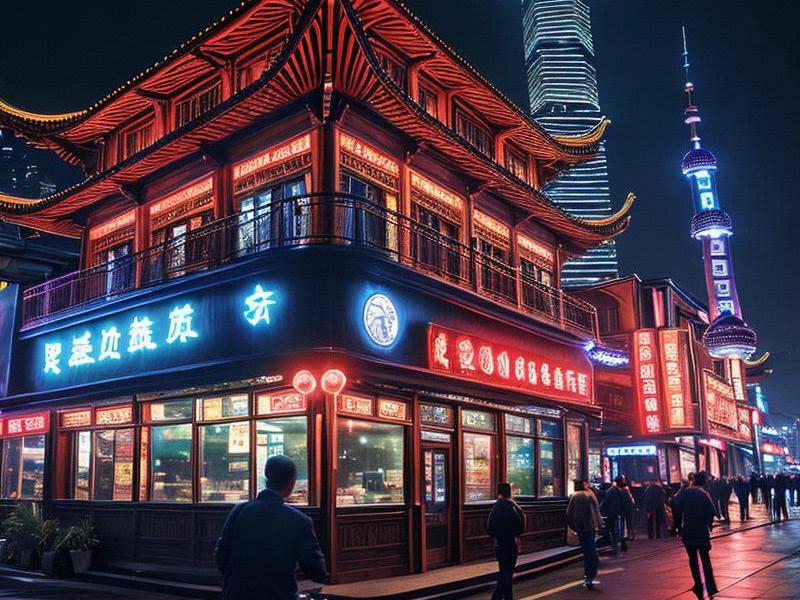This article delves into the vibrant nightlife scene in Shanghai, exploring the diverse range of entertainment venues that make the city a hub for cultural and social activities. From high-end nightclubs to traditional tea houses, Shanghai offers a unique blend of old and new, catering to a wide array of tastes and preferences.

Shanghai, the bustling metropolis on the banks of the Huangpu River, has long been a symbol of China's rapid modernization and cultural evolution. In recent years, its nightlife scene has become one of the most dynamic and diverse in the world, attracting both locals and international visitors. This article takes a closer look at the various entertainment venues that make Shanghai's nightlife a must-experience.
One of the most iconic symbols of Shanghai's nightlife is the Bund, the city's waterfront area that offers stunning views of the Pudong skyline. Here, the night comes alive with a mix of high-end bars, restaurants, and clubs. The Bund 18, for instance, is a historic building that has been transformed into a trendy venue offering panoramic views of the river and the city lights. It features a rooftop bar, a restaurant, and a nightclub, making it a popular spot for both day and night activities.
As the sun sets, the Bund transforms into a hive of activity, with people streaming in to enjoy the vibrant nightlife. The area is dotted with high-end bars and restaurants, offering a wide range of drinks and cuisines. These establishments not only provide a place to relax and unwind but also serve as social hubs where people can meet and network.
However, Shanghai's nightlife is not just about high-end clubs and trendy bars. The city also boasts a rich cultural scene, with traditional tea houses and opera performances that offer a glimpse into its rich history and heritage. In the old town area of Zhabei, for example, you can find the famous Yu Garden, which houses several traditional tea houses. These tea houses provide a serene and tranquil environment where visitors can enjoy a cup of tea while listening to traditional Chinese music.
上海龙凤419足疗按摩
The tea houses in Shanghai are not just places to drink tea; they are also cultural institutions that preserve and promote traditional Chinese culture. The staff at these tea houses are often skilled in the art of tea ceremony, and they take great pride in serving their guests with the utmost respect and attention to detail. Visitors can learn about the different types of tea, the proper way to brew them, and the history behind each variety.
In addition to tea houses, Shanghai is also home to several opera houses that showcase traditional Chinese opera performances. The Shanghai Grand Theatre, for instance, is a world-renowned venue that hosts a variety of performances, including Peking opera, Kunqu opera, and modern dance shows. These performances are not only a treat for the eyes but also an opportunity to learn about China's rich cultural heritage.
The Shanghai Grand Theatre is a masterpiece of modern architecture that combines traditional Chinese elements with contemporary design. Its stunning facade and interior make it a visual spectacle in itself, while its acoustics and stage technology ensure an unforgettable performance experience. Whether you are a fan of traditional Chinese opera or a first-time visitor, the Shanghai Grand Theatre offers an unforgettable cultural experience.
上海花千坊419
For those seeking a more contemporary nightlife experience, Shanghai's shopping districts are a haven of entertainment options. Nanjing Road and Huaihai Road are two of the city's most famous shopping areas, offering a wide range of bars, clubs, and live music venues. These areas are particularly popular among young people, who come to dance the night away and enjoy the vibrant atmosphere.
Nanjing Road, in particular, is a shopper's paradise, with its numerous high-end stores, restaurants, and entertainment venues. At night, the area comes alive with neon lights and the sound of music, creating a lively and energetic atmosphere. The street is lined with bars and clubs that offer everything from live music to DJ sets, catering to a wide range of tastes and preferences.
Huaihai Road, on the other hand, is known for its trendy cafes, bars, and art galleries. This area has a more laid-back vibe, making it a popular spot for those looking to unwind after a day of shopping. The street is dotted with cozy cafes and bars that offer a variety of drinks and snacks, as well as live music performances and art exhibitions.
上海喝茶服务vx
Shanghai's nightlife scene is not without its challenges, however. The city's rapid development and urbanization have led to concerns about overcrowding and noise pollution in certain areas. Additionally, the high cost of living in Shanghai has made some entertainment venues less accessible to locals and tourists alike.
To address these issues, the city government has implemented various measures to promote a more sustainable and inclusive nightlife scene. These include regulations on noise levels, licensing requirements for entertainment venues, and initiatives to support local businesses and artists.
Despite these challenges, Shanghai's nightlife remains a vibrant and dynamic part of the city's cultural landscape. It offers a unique blend of traditional and contemporary experiences, catering to a wide range of tastes and preferences. Whether you are looking for a high-end club, a traditional tea house, or a live music venue, Shanghai has something for everyone.
In conclusion, Shanghai's nightlife is a testament to the city's rich cultural heritage and rapid modernization. From the iconic Bund to the historic tea houses in Zhabei, the city offers a diverse range of entertainment options that cater to a wide array of tastes and preferences. While challenges remain, the city's vibrant nightlife scene continues to attract locals and international visitors alike, making it a must-experience destination for anyone visiting Shanghai.